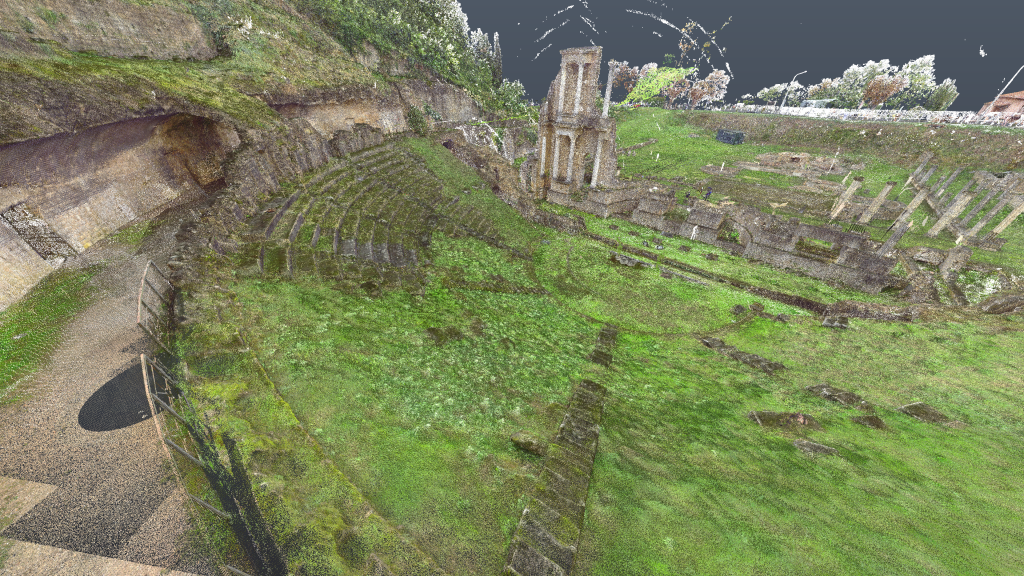The project is sponsored by the non-profit Volterra-Detroit Foundation in collaboration with the City of Volterra and is supported by Autodesk, Case Technologies
Autodesk, Case Technologies, and the Volterra-Detroit Foundation led a two-week project to 3D scan key historical and archaeological sites in the ancient city of Volterra in Italy. An international team of architects, engineers, historians and students used innovative technologies including drones, photogrammetry, and laser scanning reality capture techniques, together with Autodesk ReCap 360 software, to digitally record the city’s buildings, roads and artefacts.
Why Volterra? The city itself was built over 3,000 years ago and contains historic sites dating back to the fourth century BC. As well as being one of the oldest continuously inhabited cities in the world, it also is home to the world’s oldest standing Etruscan arch. The city also contains one of the best examples of a Roman Theatre, excavated just 50 years ago, and continues to reveal new archaeological treasures such as a Roman Amphitheatre discovered just last year.
“Thanks to the experience and dedication of a diverse group of professionals, and a close partnership with the City of Volterra, it was possible to digitally capture the city and its rich history,” said Tristan Randall, strategic project executive at Autodesk. “Not only will the scans and models captured during this project help architects and urban planners with future restoration but it also protects and preserves the artistic and cultural heritage of Volterra for future generations through interactive and virtual experiences.”
Of the 7,000 citizens within the medieval walls of Volterra, perhaps the most supportive of this project is Marco Buselli, Mayor of Volterra, who commented, “This project gives us an exceptional opportunity to photograph, map and reproduce every corner of our historical and cultural heritage that has unique and unrepeatable characteristics. We now have a virtual history book of Volterra that captures three thousand years’ worth of overlapped history from this harmonious city.”
Dr. Wladek Fuchs, president of the Volterra-Detroit Foundation, established the Volterra International Residential College where the workshop team was based during the project. “I’ve been researching the ancient architectural history of Volterra for over twenty years and this project is preserving the cultural heritage of the city for many more years to come. By digitally capturing these historic portions of the city, the history of Volterra can now be brought to life for historians, students and academics around the world. It has been my dream for years to see projects of this caliber happen at the Volterra International Residential College and my hope is that in partnership with the city of Volterra we will be able to continue telling the world about the ancient history of Volterra for future generation,” said Dr. Fuchs. Among the project team at the Volterra Residential College were representatives from Case Technologies, Civil and Environmental Consultants, CanFly Drones, The Beck Group and Paul F. Aubin Consulting Services.
The project consisted of three phases; digitally recreating historical and archaeological artefacts, creating Building Information Models of historic buildings and architectural features, and creating 3D interactive models of ancient historical sites.
 Image courtesy of Autodesk and the Volterra-Detroit Foundation.
Image courtesy of Autodesk and the Volterra-Detroit Foundation.
Phase one: Creating a digital 3D model of historical and archaeological sites
The project team used 3DR drones equipped with cameras using 3DR’s Site Scan software and Faro laser scanners to scan the significant historical structures inside the city walls, including the ruins of the Roman theatre. The data captured was then processed in point clouds and 3D models using the photogrammetry and laser scanning technology in Autodesk ReCap 360. These models were then combined with geographic information system (GIS) visuals such as land surface, roads, and rivers using Autodesk technology, to create a complete 3D digital model of the city.
 Image courtesy of Silviu Stoian and the Volterra-Detroit Foundation.
Image courtesy of Silviu Stoian and the Volterra-Detroit Foundation.
Phase two: Use of Building Information Model (BIM)
The project team then created detailed 3D models of historic buildings and architectural features by capturing the buildings using laser scanning technology. The team then transferred the point clouds into Autodesk Revit to build a detailed Building Information Model (BIM), which can be used in partnership with the City of Volterra and the Volterra-Detroit Foundation for maintenance and future restoration projects.
 Image courtesy of Paul F. Aubin and the Volterra-Detroit Foundation.
Image courtesy of Paul F. Aubin and the Volterra-Detroit Foundation.
Phase three: Creating 3D models of artworks and sculptures
Ancient artwork and sculptures contained in Volterra’s premiere museums, as well as architectural features from around the city, were captured with high-resolution digital cameras and turned into 3D models and point clouds using Autodesk ReCap 360 and Autodesk ReMake. The 3D models of the artefacts will be used in virtual exhibitions, for research and conservation purposes, and can also be 3D printed to make replicates should the need arise.
The Volterra-Detroit Foundation workshop team consisted of Tristan Randall, Autodesk,Inc., Mark Dietrick and Touf Hassoun of Case Technologies, Inc., Rob Sinclair, Rick Celender and Matt Bainbridge of Civil and Environmental Consultants, Paul Aubin of Paul F. Aubin Consulting Services, Silviu Stoian of The Beck Group and Marc Dubrule of CanFly Drones. Without their countless hours spent scanning the city of Volterra over two weeks, this project would not have been possible.